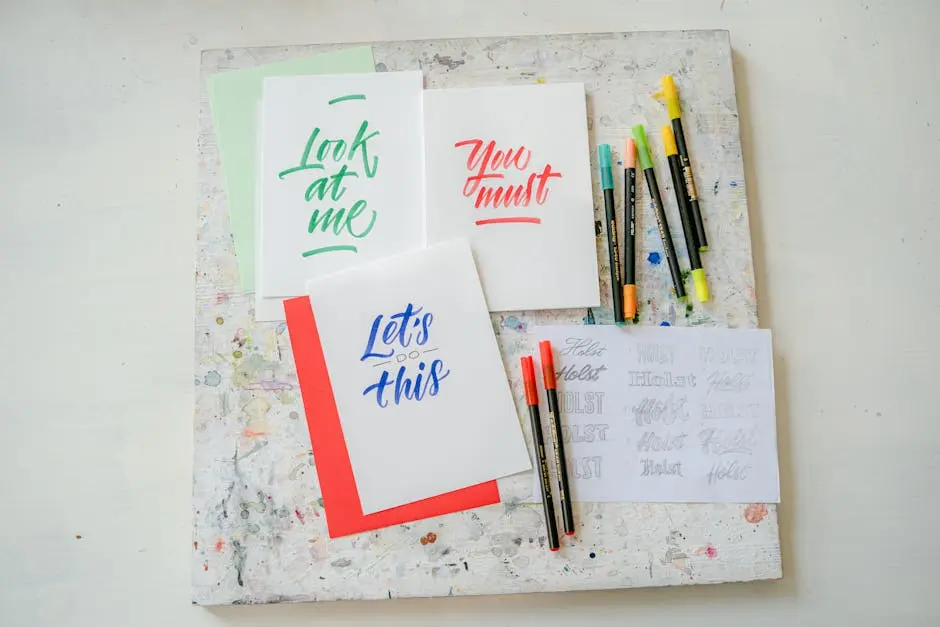Calligraphy is a beautiful art form that requires precision, practice, and, most importantly, the right tools. In this guide, we will share essential tips to help you master calligraphy using the best pens for your craft. Whether you are a beginner or looking to enhance your skills, these insights will set you on the path to stunning lettering.
1. Understanding Different Types of Calligraphy Pens
Before diving into calligraphy, it’s essential to know the different types of pens available. From dip pens to brush pens, each has its unique features and uses. Dip pens, for instance, allow for a customizable experience since you can change the nibs according to the style you are aiming for. On the other hand, brush pens are incredible for achieving fluid strokes with varying thicknesses, giving a more dynamic feel to your lettering.
Additionally, there are also fountain pens that are quite popular among calligraphy enthusiasts. These pens come with built-in ink reservoirs, which means you can write for longer periods without interruptions. Understanding the different types means you’ll be more equipped to choose the right tool that suits your writing style.
2. Choosing the Right Nib for Your Style
The nib is the heart of any pen. Selecting the appropriate nib size and style can significantly impact your calligraphy results. Wider nibs produce bolder strokes, perfect for display pieces, while finer nibs are ideal for detailed work and intricate designs. It’s all about finding what resonates with your artistic vision.
Don’t hesitate to experiment with various nibs; your skills will improve as you understand how each one responds to different movements. For instance, a flexible nib can create both thin and thick lines by varying the pressure, which can add a beautiful dynamic quality to your writing. Therefore, choosing the right nib is not only about the size but also the intended stroke variation.
3. Experimenting with Ink Types
Not all inks are created equal. Exploring different ink types will help you find the finish that best suits your style. Traditional calligraphy inks offer rich pigments, but you might also want to consider fountain pen inks or even sumi ink for its deep color quality. Each type will create a different effect and feel when you write.
Let your creativity flow as you try out metallic inks or vibrant colors that can elevate your calligraphy game to the next level. Just keep in mind that some inks work better with specific nibs, so your experimentation may lead to some exciting discoveries!
4. Perfecting Your Grip and Stroke
A comfortable grip can make a world of difference. Learning how to hold your pen correctly is the first step to achieving fluid movements. Whether you’re gripping your pen with a traditional or modern style, ensuring that your grip allows for flexibility is crucial.
Pay attention to your wrist and arm movement as well; they should remain relaxed to facilitate smooth strokes. As you practice, focus on maintaining proper posture and angles while writing. This attention to detail can drastically improve the fluidity and elegance of your lettering.
5. Practicing Consistent Letterforms
Consistency is key in calligraphy. Practicing your letterforms regularly will help you maintain uniformity and improve your overall style. One effective technique is to practice specific letterforms repeatedly until you can confidently write them without needing to think too much about the strokes.
You might also consider creating a series of worksheets or templates that focus on particular letters or styles. This structured approach can guide you through the learning curve, allowing you to focus on one aspect of your calligraphy at a time.
6. Utilizing Guides and Worksheets
Guides and worksheets serve as excellent tools for honing your skills. They provide a structured way to practice and refine each letter. You can find numerous resources online or even create your own by printing examples of letters and practicing over them.
Some practitioners find great success in using tracing paper, allowing them to follow along with the exact forms of letters they wish to master. With time and dedication, your muscle memory will enhance your ability to create beautiful letterforms seamlessly.
7. Incorporating Personal Touches
Your calligraphy should reflect your personality! Incorporate unique elements that make your work stand out. This might mean using unconventional colors or adding little embellishments that tell your story.
Think about blending styles or experimenting with flourishes that resonate with you. At the end of the day, calligraphy is not just about the letters; it’s about infusing your essence into your art, making it uniquely yours.
8. Showcasing Your Calligraphy Creations
Once you’ve mastered your skills, it’s time to share your work. Whether through social media or crafting beautiful gifts, show the world your talent. Sharing your journey can also connect you with fellow calligraphers and art enthusiasts who appreciate the beauty and effort you put into your creations.
Consider starting a portfolio website or an Instagram account dedicated to your work. Regularly uploading your calligraphy can not only inspire others but also hold you accountable, pushing you to continue honing your skills. After all, the beauty of calligraphy lies in continuous learning and growth.


